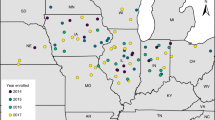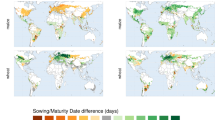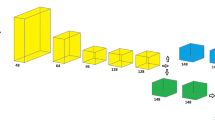Abstract
Farmers in the USA have rapidly expanded the use of cover crops, with the national cover crop area nearly doubling since 2012. Despite many benefits that motivate public subsidies, questions remain about potential downsides. Here, using satellite observations from over 100,000 fields, half of which recently adopted cover crops, we demonstrate both positive and negative impacts of cover cropping, including: (1) declines in average yields for corn and soybean, by ~3% and ~2%, respectively; (2) delays in planting of corn (4 days) and soybean (2.5 days); and (3) reduced damages in the wet spring of 2019, with cover crop fields only half as likely to experience prevented planting as non-cover-crop fields. Cover cropping appears to reduce important aspects of farmer risk in wet conditions but increase them in dry conditions. Timely planting of the cash crop deserves emphasis moving forward, as we show eliminating planting delays would reduce yield penalties by roughly 50% for corn and 90% for soybean.
This is a preview of subscription content, access via your institution
Access options
Access Nature and 54 other Nature Portfolio journals
Get Nature+, our best-value online-access subscription
$32.99 / 30 days
cancel any time
Subscribe to this journal
Receive 12 digital issues and online access to articles
$119.00 per year
only $9.92 per issue
Buy this article
- Purchase on SpringerLink
- Instant access to full article PDF
Prices may be subject to local taxes which are calculated during checkout






Similar content being viewed by others
Data availability
The data used in this study are available via Zenodo at https://doi.org/10.5281/zenodo.15492771 (ref. 38).
Code availability
The scripts used for all data analysis and figure generation in this study are available via Zenodo at https://doi.org/10.5281/zenodo.15492771 (ref. 38).
References
NRCS Financial Assistance Program Practices Data. USDA (2024); https://www.farmers.gov/data/financial-assistance-download
Kathage, J., Smit, B., Janssens, B., Haagsma, W. & Adrados, J. L. How much is policy driving the adoption of cover crops? Evidence from four EU regions. Land Use Policy 116, 106016 (2022).
Won, S., Rejesus, R. M., Goodwin, B. K. & Aglasan, S. Understanding the effect of cover crop use on prevented planting losses. Am. J. Agric. Econ. https://doi.org/10.1111/ajae.12396 (2023).
Blanco-Canqui, H. et al. Cover crops and ecosystem services: insights from studies in temperate soils. Agron. J. 107, 2449–2474 (2015).
Abdalla, M. et al. A critical review of the impacts of cover crops on nitrogen leaching, net greenhouse gas balance and crop productivity. Glob. Change Biol. 25, 2530–2543 (2019).
Kaye, J. et al. Managing nitrogen through cover crop species selection in the U.S. Mid-Atlantic. PLoS ONE 14, e0215448 (2019).
Han, G. & Niles, M. T. An adoption spectrum for sustainable agriculture practices: a new framework applied to cover crop adoption. Agric. Syst. 212, 103771 (2023).
Lobell, D. B. & Villoria, N. B. Reduced benefits of climate-smart agricultural policies from land-use spillovers. Nat. Sustain. https://doi.org/10.1038/s41893-023-01112-w (2023).
Peng, Y., Wang, L., Jacinthe, P.-A. & Ren, W. Global synthesis of cover crop impacts on main crop yield. Field Crops Res. 310, 109343 (2024).
Vendig, I. et al. Quantifying direct yield benefits of soil carbon increases from cover cropping. Nat. Sustain 6, 1125–1134 (2023).
Garba, I. I., Bell, L. W. & Williams, A. Cover crop legacy impacts on soil water and nitrogen dynamics, and on subsequent crop yields in drylands: a meta-analysis. Agron. Sustain. Dev. 42, 34 (2022).
Basche, A. D. et al. Soil water improvements with the long-term use of a winter rye cover crop. Agric. Water Manag. 172, 40–50 (2016).
Silva, T. S. et al. Cereal rye cover crop termination at or before soybean planting has minimal effect on soybean yield across the midwestern US. Field Crops Res. 312, 109393 (2024).
Wallander, S., Smith, D., Bowman, M. & Claassen, R. Cover crop trends, programs, and practices in the United States. US Department of Agriculture, Economic Research Service https://www.ers.usda.gov/publications/pub-details?pubid=100550 (2021).
Deines, J. M. et al. Recent cover crop adoption is associated with small maize and soybean yield losses in the United States. Glob. Change Biol. 00, 794–807 (2022).
Bastidas, A. M. et al. Soybean sowing date: the vegetative, reproductive, and agronomic impacts. Crop Sci. 48, 727–740 (2008).
Mourtzinis, S., Specht, J. E. & Conley, S. P. Defining optimal soybean sowing dates across the US. Sci. Rep. 9, 2800 (2019).
Blanco‐Canqui, H. & Ruis, S. J. Cover crop impacts on soil physical properties: a review. Soil Sci. Soc. Am. J. 84, 1527–1576 (2020).
Cause of loss. Risk Management Agency https://www.rma.usda.gov/tools-reports/summary-of-business/cause-loss (2025).
Ma, M., Reeling, C., Hughes, M. N., Armstrong, S. & Roth, R. Comparison of conservation instruments under long-run yield uncertainty and farmer risk aversion. Eur. Rev. Agric. Econ. 50, 1685–1714 (2023).
Ting, M., Seager, R., Li, C., Liu, H. & Henderson, N. Future summer drying in the U.S. Corn Belt and the role of midlatitude storm tracks. J. Clim. 34, 9043–9056 (2021).
Wilson, A. B. et al. Chapter 24: Midwest. Fifth National Climate Assessment. US Global Change Research Program https://repository.library.noaa.gov/view/noaa/61592 (2023).
Kluger, D. M., Owen, A. B. & Lobell, D. B. Combining randomized field experiments with observational satellite data to assess the benefits of crop rotations on yields. Environ. Res. Lett. 17, 044066 (2022).
Zhou, Q. et al. Recent rapid increase of cover crop adoption across the U.S. midwest detected by fusing multi‐source satellite data. Geophys. Res. Lett. 49, e2022GL100249 (2022).
Ma, Y., Liang, S.-Z., Myers, D. B., Swatantran, A. & Lobell, D. B. Subfield-level crop yield mapping without ground truth data: a scale transfer framework. Remote Sens. Environ. 315, 114427 (2024).
Deines, J. M. et al. Field-scale dynamics of planting dates in the US Corn Belt from 2000 to 2020. Remote Sens. Environ. 291, 113551 (2023).
Boryan, C., Yang, Z., Mueller, R. & Craig, M. Monitoring US agriculture: the US Department of Agriculture, National Agricultural Statistics Service, Cropland Data Layer Program. Geocarto Int. 26, 341–358 (2011).
Wager, S. & Athey, S. Estimation and inference of heterogeneous treatment effects using random forests. J. Am. Stat. Assoc. 113, 1228–1242 (2018).
Athey, S., Tibshirani, J. & Wager, S. Generalized random forests. Ann. Stat. 47, 1179–1203 (2019).
De Chaisemartin, C. & D’HaultfŒuille, X. Fuzzy differences-in-differences. Rev. Economic Stud. 85, 999–1028 (2018).
Breiman, L. Random forests. Mach. Learn. 45, 5–32 (2001).
Gridded soil survey geographic (gSSURGO) database user guide. National Resource Conservation Service https://www.nrcs.usda.gov/sites/default/files/2022-08/gSSURGO_UserGuide_July2020.pdf (2014).
Athey, S. & Wager, S. Estimating treatment effects with causal forests: an application. Observational Stud. 5, 37–51 (2019).
Deines, J. M., Wang, S. & Lobell, D. B. Satellites reveal a small positive yield effect from conservation tillage across the US Corn Belt. Environ. Res. Lett. 14, 124038 (2019).
Carroll, R. J. Measurement Error in Nonlinear Models: A Modern Perspective (CRC Press, 2006).
Deines, J. M., Patel, R., Liang, S.-Z., Dado, W. & Lobell, D. B. A million kernels of truth: insights into scalable satellite maize yield mapping and yield gap analysis from an extensive ground dataset in the US Corn Belt. Remote Sens. Environ. 253, 112174 (2021).
Irwin, S. What do we know about planting dates and corn and soybean yield from agronomic field trials? Farmdoc Daily 12, 51 (2022).
Di Tommaso, S. & Lobell, D. The mixed effects of recent cover crop adoption on U.S. cropland productivity. Zenodo https://doi.org/10.5281/zenodo.15492771 (2025).
Acknowledgements
Funding was provided by NASA Acres (NASA Applied Sciences grant no. 80NSSC23M0034, subaward 124245-Z6512205 to D.B.L.) and the Keck Foundation (to D.B.L.).
Author information
Authors and Affiliations
Contributions
D.B.L., J.S. and K.G. designed the research; Q.Z. and Y.M. contributed new data; S.D.T., Q.Z. and D.B.L. analysed the data; Q.Z. and K.G. developed cover crop data and conducted field validation; and D.B.L. wrote the initial manuscript. All authors contributed to final manuscript.
Corresponding author
Ethics declarations
Competing interests
The authors declare no competing interests.
Peer review
Peer review information
Nature Sustainability thanks Timothy Bowles, Sami Khanal and the other, anonymous, reviewer(s) for their contribution to the peer review of this work.
Additional information
Publisher’s note Springer Nature remains neutral with regard to jurisdictional claims in published maps and institutional affiliations.
Extended data
Extended Data Fig. 1 Illustration of the difference-in-difference (DID) estimation of treatment effects for yield and planting date outcomes for each crop.
Dashed lines indicate the expected change in outcomes for the treatment group between the pre-treatment period (2000-2009) and post-treatment period (2016-2022) under a parallel trends assumption. The value of d represents the inferred effect of cover crop on each outcome, before adjusting for measurement error in cover crop estimates.
Extended Data Fig. 2 Distribution of covariates for 2000-2022 on treatment and control fields.
Boxplots show median as horizontal thick line, 25%-75% as colored box, and range as vertical lines (with outliers shown as separate points). Distributions are shown for corn samples, but distributions were very similar for soybean samples.
Extended Data Fig. 3 Trends in yields and planting dates for treatment and control fields during the pre-treatment period (2000–2009), shown separately for corn and soybean.
Panels a and b show yield (a) and planting date (b) trends for corn; panels c and d show yield (c) and planting date (d) trends for soybean.
Extended Data Fig. 4 Log yield vs planting date for corn (a) and soy (b) for each year, along with best-fit linear regression.
Values are centered to remove county effects, since the models included a fixed effect for county.
Extended Data Fig. 5 Fallow areas are a reliable measure of prevented planting in 2019.
Left panel shows reported area of prevented planted according to USDA Farm Service Agency (FSA) for corn and soy for the six states over time, illustrating the large increase in 2019 compared to other years in the study period. Right panel shows agreement between county-level prevented planted area in FSA and total area in the Cropland Data Layer Fallow/Idle Cropland class area, aggregated to the county scale in 2019.
Extended Data Fig. 6 Yield and planting date effects do not clearly diminish with longer adoption periods.
Panels show estimates of yield (left) and planting date (right) impacts when subsetting fields from the original treatment sample (3+ years of cover crop adoption) to more restrictive samples that consider fields with longer adoption histories. Data are presented as point estimates (means) ± 95% confidence intervals, based on standard errors clustered at the state level. The number of cover-cropped fields in each group is shown below each point in the figure, separately for corn and soybean.
Extended Data Fig. 7 Location of Control and Treatment samples.
Points show the samples for the corn analysis, with 55,921 control and 57,410 treatment locations. The corresponding numbers for soybean are 56,039 control and 58,000 treatment.
Extended Data Fig. 8 Results of difference-in-differences (DID) analysis when using absolute yield (t/ha) rather than log-transformed yield.
Results shown in Fig. 3 of the main paper are based on a model using log yield. Here, corn and soy results are shown separately due to differences in absolute yield scales (average yields in our sample are 10.9 t/ha for corn and 3.3 t/ha for soy). Values are shown for the pooled sample (a), individual years (b), and individual states (c). Data are presented as point estimates (means) ± 95% confidence intervals, based on standard errors clustered at the state level.
Supplementary information
Supplementary Information
Supplementary Tables 1 and 2 and references.
Rights and permissions
Springer Nature or its licensor (e.g. a society or other partner) holds exclusive rights to this article under a publishing agreement with the author(s) or other rightsholder(s); author self-archiving of the accepted manuscript version of this article is solely governed by the terms of such publishing agreement and applicable law.
About this article
Cite this article
Lobell, D.B., Di Tommaso, S., Zhou, Q. et al. The mixed effects of recent cover crop adoption on US cropland productivity. Nat Sustain 8, 1004–1012 (2025). https://doi.org/10.1038/s41893-025-01599-5
Received:
Accepted:
Published:
Issue date:
DOI: https://doi.org/10.1038/s41893-025-01599-5



